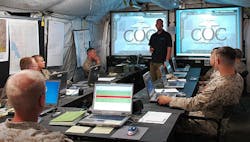Officials of the Naval Air Warfare Center Weapons Division (NAWCWD) at China Lake Naval Air Weapons Station in Ridgecrest, Calif., awarded a $12 million four-year contract to CSCI for software enhancements intended to overcome limitations in how unmanned aerial vehicles (UAVs) exchange control and sensor information with ground-control centers and tactical aircraft.
The contract calls for CSCI experts to design software and engineer the Dynamically Adaptive Secure Area Network (DASCAN) system, which is the central component of the U.S. Marine Corps Tactical Operations Center and Command Operations Center (TOC/COC) architecture.
The Marine Corps COCs, designed by General Dynamics C4 Systems in Scottsdale, Ariz., are the focal point of decision-making during all phases of ground warfare.
The COCs enable Marine forces to collect, process, and disseminate tactical data digitally, and are mobile, modular command and control centers designed to support Marines and other users wherever they are deployed, including for pre-deployment training and testing.
Since General Dynamics designed the COC, its official name has changed to the AN/TSQ-239 Combat Operations Center, and engineers at iGov in Reston, Va., are modernizing the COCs under terms of a four-year $100 million contract awarded last year.
The COC provides mobile, modular command and control centers across the span of tactical command from battalion to divisional level. It provides tactical data and C2 systems to the headquarters, including maneuver, fires, intelligence, logistics and administration.
The system integrates non-secure, secret voice and data communications, Voice over Internet Protocol (VoIP) capabilities and networked servers. Several different networks provide security and accessibility among interoperable users.
CSCI experts also will provide technical help at Marine Aviation Weapons Tactics Squadron (MAWTS) Weapons Tactics Instructor (WTI) events at Yuma Marine Corps Air Station, Ariz., as well as describe intelligence, surveillance, reconnaissance, and targeting (ISRT) communications capabilities.
In addition, CSCI will perform data analysis and modeling to ensure that aircraft can continue to exchange surveillance and targeting data with Marine Corps Tactical Operations Centers and Combat Operations Centers.
Related: DARPA releases network security solicitation to operate through bad wireless nodes
This effort will enable officials of the NAWCWD Mission Engineering and Interoperability (MEI) Division to move TOC/COC systems to a program of record for deployment and sustainment, Navy officials say.
CSCI developed the DASCAN system and demonstrated it in the TOC during the MAWTS WTI course exercise at Yuma in April 2013. The DASCAN system has been certified for classified operations within the tactical Secret Internet Protocol Router Network (SIPRNet) at MAWTS.
Military officials are recommending that CSCI enhance the DASCAN system with full-motion video and imagery capability, and ensure that DASCAN can exchange surveillance and control data with tactical aircraft.
Related: The challenge of a secure military cloud
CSCI owns a software program called the Performance-Responsive Intelligent Stream Manager (PRISM) Network Integration Service (NIS) and Content Provision Service (CPS), which has been proven to automate several network paths and deliver video even under heavy data loads.
Navy officials are awarding the contract to CSCI sole-source, because this software represents the only known package that can monitor networks in real time with bandwidth-dependent full-motion-video transcoding and dissemination across Marine Corps classified networks, officials say.
Opening up the necessary DASCAN upgrades to competition would cost an extra $8 million and delay the program for two years, Navy officials say. On this contract CSCI will do the work in Springfield, Va., and should be finished by March 2018.
For more information contact CSCI online at www.csci-va.com, or the Naval Air Warfare Center Weapons Division at www.navair.navy.mil/nawcwd.



